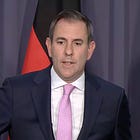The Reserve Bank of Australia dramatically downgraded its productivity growth assumptions by 30% Tuesday, warning that persistent weakness in economic output threatens to keep wage growth subdued for years ahead.
The central bank cut its productivity growth assumption from 1% to 0.7% annually, acknowledging it has consistently overestimated Australia's economic capacity since productivity growth flatlined in 2016.
Governor Michelle Bullock said the downgrade helps explain why the RBA has repeatedly missed its economic forecasts while accurately predicting inflation and employment outcomes.
"The productivity adjustment is actually closing a bit of a puzzle we had about why we were hitting our inflation forecast and our unemployment forecast and the wages forecast were underperforming a bit," Bullock told reporters following the bank's decision to cut interest rates to 3.6%.
The productivity revision carries profound implications for Australian living standards, with weaker output growth directly constraining how much real wages can rise without fueling inflation.
Wage Growth Implications
The bank's acknowledgment that productivity has stagnated since 2016 means real wages cannot grow substantially without creating inflationary pressures, limiting improvements in household purchasing power.
"Weaker productivity growth in the terms of our forecasts, the implications of that I think are already being felt," Bullock said. "Real wages are not rising very much because that's the implication of slow productivity growth is that real wages can't grow as quickly."
The productivity assumption affects wage forecasts throughout the bank's two-year outlook period, suggesting continued modest income growth for Australian workers.
"If we can get productivity growth up, are that that will allow for more growth in real wages, which is ultimately good for Australians," Bullock said.
Forecasting Puzzle Resolved
The RBA admitted it has been consistently overestimating GDP and consumption growth while accurately hitting employment and inflation targets, creating what officials described as a "puzzle" in their economic modeling.
The productivity downgrade resolves this inconsistency by acknowledging the economy's reduced capacity to generate output growth.
"We were overestimating our GDP and our consumption forecasts," Bullock explained. "So there was a tension in the forecast. Why were we hitting our targets when we weren't hitting? And part of the solution to that was that the productivity assumption was a little too high."
The bank's new 0.7% productivity assumption is based on Australia's average 20-year productivity growth prior to COVID-19, representing a more conservative baseline for economic projections.
Rate Cut Delivers Relief
Alongside the productivity revision, the RBA cut interest rates by 0.25 percentage points to 3.6%, the lowest level since April 2023 and the third reduction in four months.
The unanimous board decision reflects growing confidence that inflation is returning sustainably to the bank's 2-3% target range without triggering a sharp rise in unemployment.
"The forecasts imply that the cash rate might need to be a bit lower than it is today to keep inflation low and stable and employment growing," Bullock said.
Financial markets had fully priced in the rate cut following the bank's shock decision to hold rates steady in July despite mounting pressure for relief.
Government Response Expected
The productivity findings come just days before Bullock addresses the government's productivity summit, where policymakers will examine strategies to boost Australia's economic output.
The RBA governor will deliver a scene-setting presentation on economic resilience and how reforms can strengthen productivity performance.
"The government is very focused on what we need to do to lift productivity in a long-run sense," Bullock said, emphasizing the central bank cannot directly influence productivity outcomes.
"All the Reserve Bank can do is make sure we have low and stable inflation and if we have full employment, both of those things are very stable environments for businesses to think about how they might improve productivity."
Business Investment Concerns
The productivity struggles reflect broader challenges in business investment and innovation across the Australian economy, with companies appearing reluctant to invest in productivity-enhancing technologies.
Business liaison reports highlighted ongoing price pressures in software and technology costs, potentially deterring productivity investments.
"We do know from businesses more broadly that input costs are rising and they're having difficulty passing those costs on," Bullock said.
The governor noted that weak demand has prevented many businesses from passing higher costs to consumers, forcing them to absorb increases that might otherwise fund productivity improvements.
Mining Sector Drag
Part of Australia's productivity decline stems from structural shifts in the mining sector, where companies increasingly extract harder-to-reach resources requiring more capital and labor per unit of output.
"As we mine all the easy-to-get stuff and we have to move into mining the ore that's harder to get, then you're having to expend more capital and labour to get that ore out of the ground," Bullock explained.
The bank expects mining productivity to stabilize rather than rebound substantially, contributing to the overall conservative productivity outlook.
Labor Market Implications
The productivity challenge coincides with what the RBA describes as a "bit tight" labor market, where businesses struggle to find skilled workers while unemployment remains near historic lows at 4.3%.
This dynamic creates competing pressures, with tight labor conditions potentially encouraging productivity investments while also driving up wage costs.
"If we can maintain where we are, I don't think that's a bad thing," Bullock said of current labor market conditions. "It will keep businesses focused on where can we make savings? Where can we make productivity improvements?"
However, the governor warned against allowing labor markets to become too tight, which could fuel wage growth that outpaces productivity gains.
Truth matters. Quality journalism costs.
Your subscription to The Evening Post (Australia) directly funds the investigative reporting our democracy needs. For less than a coffee per week, you enable our journalists to uncover stories that powerful interests would rather keep hidden. There is no corporate influence involved. No compromises. Just honest journalism when we need it most.
Not ready to be paid subscribe, but appreciate the newsletter ? Grab us a beer or snag the exclusive ad spot at the top of next week's newsletter.
Housing Market Boost
Despite productivity concerns, the RBA's rate cuts are already stimulating dwelling investment, with construction forecasts doubled in just three months.
"What we're hearing from liaison is that some of the tightness in construction inputs, in particular labour, has been easing somewhat," Bullock said.
The recovery in housing construction represents one bright spot for productivity, with new dwelling investment potentially boosting overall economic capacity.
Global Context
Australia's productivity struggles mirror challenges facing developed economies worldwide, though the RBA maintains the domestic focus of its policy settings.
International uncertainties, including potential changes to U.S. Federal Reserve independence and global trade tensions, add complexity to Australia's economic outlook.
"We expect global growth to slow over the rest of the year and into 2026, as impacts from higher tariffs and broader policy uncertainty weigh on activity," Bullock said.
Economic Forecasts
The bank's latest projections show inflation remaining sustainably within the 2-3% target band while unemployment holds around current levels through the forecast period.
However, GDP growth is expected to remain subdued, reflecting the productivity constraints now formally acknowledged in the bank's modeling.
The economic outlook assumes several more interest rate cuts, with markets pricing the cash rate to fall toward 3.1% by mid-2026.
Policy Challenges Ahead
The productivity revision highlights fundamental challenges facing Australian economic policy, with monetary policy limited in its ability to address structural output constraints.
"Breaking out of the productivity slowdown is a matter for the government that they are taking on," Bullock said. "There's nothing the Reserve Bank can do."
The central bank's acknowledgment of sustained productivity weakness puts greater pressure on government initiatives to boost business investment, innovation and economic reform.
Market Response
Financial markets rose following the rate cut announcement, though the productivity findings underscore longer-term challenges for corporate earnings growth and living standards.
The combination of lower interest rates and productivity constraints creates a complex environment for investors, with monetary easing providing near-term support while structural economic challenges persist.
Looking Forward
Next week's productivity summit will test the government's ability to develop concrete strategies for addressing Australia's output growth challenges.
With the RBA unable to influence productivity directly, the burden falls on fiscal policy, regulation and structural reforms to unlock economic potential.
The central bank will continue monitoring data meeting by meeting, with three more rate decisions scheduled before year-end as policymakers balance inflation control with employment objectives.
The productivity revision represents one of the most significant acknowledgments of Australia's economic constraints in recent years, setting the stage for intensified policy debates about the nation's growth trajectory.
For Australian households, the findings suggest that significant improvements in living standards may require fundamental economic reforms rather than simply lower interest rates.
The challenge now lies in translating recognition of the productivity problem into effective policy solutions that can restore Australia's capacity for sustained economic growth and rising incomes.
Got a News Tip?
Contact our editor via Proton Mail encrypted, X Direct Message, LinkedIn, or email. You can securely message him on Signal by using his username, Miko Santos.
As well as knowing you’re keeping Mencari (Australia) alive, you’ll also get:
Get breaking news AS IT HAPPENS - Gain instant access to our real-time coverage and analysis when major stories break, keeping you ahead of the curve
Unlock our COMPLETE content library - Enjoy unlimited access to every newsletter, podcast episode, and exclusive archive—all seamlessly available in your favorite podcast apps.
Join the conversation that matters - Be part of our vibrant community with full commenting privileges on all content, directly supporting The Evening Post (Australia)
Not ready to be paid subscribe, but appreciate the newsletter ? Grab us a beer or snag the exclusive ad spot at the top of next week's newsletter.












